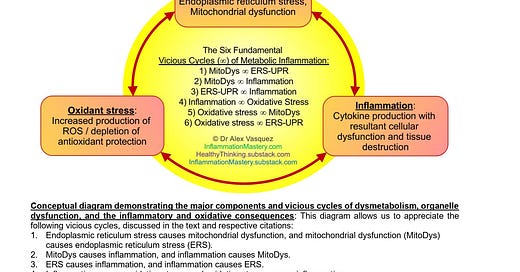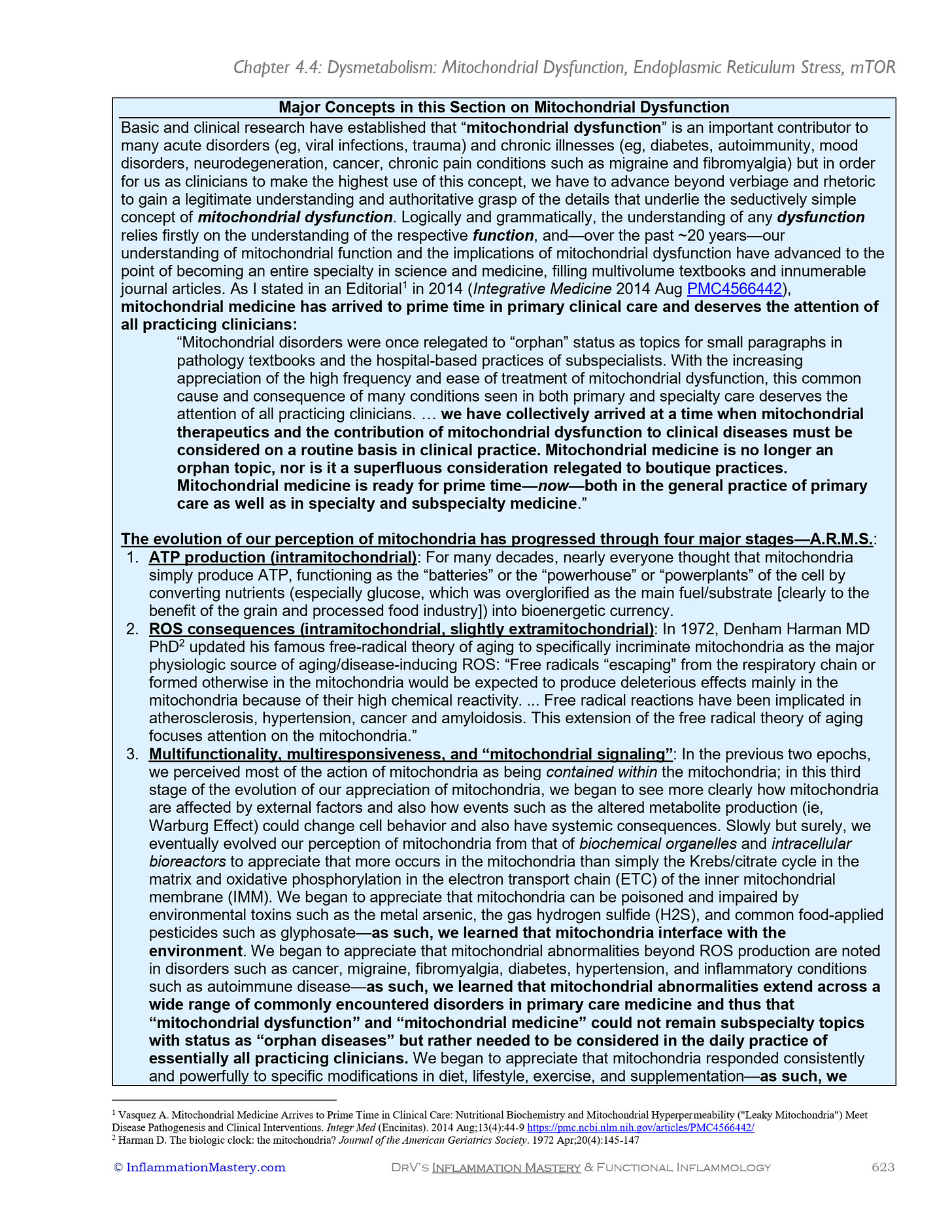Mitochondrial signaling and dysfunction 2024 update: My complete re-write of the introduction to Chapter 4.4 on "Dysmetabolism & Dysfunctional Organelles"
We’ve now traversed four levels of perception of mitochondria
Well, after re-reviewing the video and article discussed previously, I was right in my post yesterday, saying that we've reached the 4th level of understanding mitochondrial function and dysfunction. As you can see in the update below, we’ve now traversed four levels of perception of mitochondria:
ATP factories (fuel)
ROS factories (pollution)
Mitochondrial signalling, vaguely understood
Mitochondrial information processing system (MIPS)
New to mitochondrial dysfunction and mitochondrial nutrition?
See my 2013 and 2014 articles:
See my 2013 presentation:
The first three pages (pages 622-624) forming the introduction to Chapter 4.4 of Inflammation Mastery have been re-written to the following:
Major Concepts in this Section on Mitochondrial Dysfunction
Basic and clinical research have established that “mitochondrial dysfunction” is an important contributor to many acute disorders (eg, viral infections, trauma) and chronic illnesses (eg, diabetes, autoimmunity, mood disorders, neurodegeneration, cancer, chronic pain conditions such as migraine and fibromyalgia) but in order for us as clinicians to make the highest use of this concept, we have to advance beyond verbiage and rhetoric to gain a legitimate understanding and authoritative grasp of the details that underlie the seductively simple concept of mitochondrial dysfunction. Logically and grammatically, the understanding of any dysfunction relies firstly on the understanding of the respective function, and—over the past ~20 years—our understanding of mitochondrial function and the implications of mitochondrial dysfunction have advanced to the point of becoming an entire specialty in science and medicine, filling multivolume textbooks and innumerable journal articles. As I stated in an Editorial[1] in 2014 (Integrative Medicine 2014 Aug PMC4566442), mitochondrial medicine has arrived to prime time in primary clinical care and deserves the attention of all practicing clinicians:
“Mitochondrial disorders were once relegated to “orphan” status as topics for small paragraphs in pathology textbooks and the hospital-based practices of subspecialists. With the increasing appreciation of the high frequency and ease of treatment of mitochondrial dysfunction, this common cause and consequence of many conditions seen in both primary and specialty care deserves the attention of all practicing clinicians. … we have collectively arrived at a time when mitochondrial therapeutics and the contribution of mitochondrial dysfunction to clinical diseases must be considered on a routine basis in clinical practice. Mitochondrial medicine is no longer an orphan topic, nor is it a superfluous consideration relegated to boutique practices. Mitochondrial medicine is ready for prime time—now—both in the general practice of primary care as well as in specialty and subspecialty medicine.”
The evolution of our perception of mitochondria has progressed through four major stages—A.R.M.S.:
ATP production (intramitochondrial): For many decades, nearly everyone thought that mitochondria simply produce ATP, functioning as the “batteries” or the “powerhouse” or “powerplants” of the cell by converting nutrients (especially glucose, which was overglorified as the main fuel/substrate [clearly to the benefit of the grain and processed food industry]) into bioenergetic currency.
ROS consequences (intramitochondrial, slightly extramitochondrial): In 1972, Denham Harman MD PhD[2] updated his famous free-radical theory of aging to specifically incriminate mitochondria as the major physiologic source of aging/disease-inducing ROS: “Free radicals “escaping” from the respiratory chain or formed otherwise in the mitochondria would be expected to produce deleterious effects mainly in the mitochondria because of their high chemical reactivity. ... Free radical reactions have been implicated in atherosclerosis, hypertension, cancer and amyloidosis. This extension of the free radical theory of aging focuses attention on the mitochondria.”
Multifunctionality, multiresponsiveness, and “mitochondrial signaling”: In the previous two epochs, we perceived most of the action of mitochondria as being contained within the mitochondria; in this third stage of the evolution of our appreciation of mitochondria, we began to see more clearly how mitochondria are affected by external factors and also how events such as the altered metabolite production (ie, Warburg Effect) could change cell behavior and also have systemic consequences. Slowly but surely, we eventually evolved our perception of mitochondria from that of biochemical organelles and intracellular bioreactors to appreciate that more occurs in the mitochondria than simply the Krebs/citrate cycle in the matrix and oxidative phosphorylation in the electron transport chain (ETC) of the inner mitochondrial membrane (IMM). We began to appreciate that mitochondria can be poisoned and impaired by environmental toxins such as the metal arsenic, the gas hydrogen sulfide (H2S), and common food-applied pesticides such as glyphosate—as such, we learned that mitochondria interface with the environment. We began to appreciate that mitochondrial abnormalities beyond ROS production are noted in disorders such as cancer, migraine, fibromyalgia, diabetes, hypertension, and inflammatory conditions such as autoimmune disease—as such, we learned that mitochondrial abnormalities extend across a wide range of commonly encountered disorders in primary care medicine and thus that “mitochondrial dysfunction” and “mitochondrial medicine” could not remain subspecialty topics with status as “orphan diseases” but rather needed to be considered in the daily practice of essentially all practicing clinicians. We began to appreciate that mitochondria responded consistently and powerfully to specific modifications in diet, lifestyle, exercise, and supplementation—as such, we…began to appreciate that mitochondria can be poisoned and impaired by environmental toxins such as the metal arsenic, the gas hydrogen sulfide (H2S), and common food-applied pesticides such as glyphosate—as such, we learned that mitochondria interface with the environment. We began to appreciate that mitochondrial abnormalities beyond ROS production are noted in disorders such as cancer, migraine, fibromyalgia, diabetes, hypertension, and inflammatory conditions such as autoimmune disease—as such, we learned that mitochondrial abnormalities extend across a wide range of commonly encountered disorders in primary care medicine and thus that “mitochondrial dysfunction” and “mitochondrial medicine” could not remain subspecialty topics with status as “orphan diseases” but rather needed to be considered in the daily practice of essentially all practicing clinicians. We began to appreciate that mitochondria responded consistently and powerfully to specific modifications in diet, lifestyle, exercise, and supplementation—as such, we learned that mitochondrial performance and behavior could be favorably modified with low-cost low-risk high-payoff nonprescription interventions, thereby broadening the means (eg, natural) and clinical personnel (ie, nonspecialists) though which effective mitochondrial interventions could be implemented. An example of the multifunctionality of mitochondria is their role in “nutrient-dependent metabolic detoxification” of endogenous poisons/toxins such as propionic acid, propionyl-CoA, and methylmalonic acid—see my video review from 2024 Oct.** …
** https://healthythinking.substack.com/p/health-homework-39-get-these-3-laboratory
[1] Vasquez A. Mitochondrial Medicine Arrives to Prime Time in Clinical Care: Nutritional Biochemistry and Mitochondrial Hyperpermeability ("Leaky Mitochondria") Meet Disease Pathogenesis and Clinical Interventions. Integr Med (Encinitas). 2014 Aug;13(4):44-9 https://pmc.ncbi.nlm.nih.gov/articles/PMC4566442/
[2] Harman D. The biologic clock: the mitochondria? Journal of the American Geriatrics Society. 1972 Apr;20(4):145-147
3. continued …Another example of the multifunctionality of mitochondria is their ability to produce metabolites and precursors that promote immortalization and proliferation of various cell types, including immunocytes (eg, responding to infection) and cancer cells. By the end of this third era, the poorly-understood phenomena by which mitochondria influenced physiologic events at the cellular and tissue level was vaguely termed “[intracellular] mitochondrial signaling” which did not provide us conceptual or clinical clarity but nonetheless helped us comprehend and communicate that mitochondria were clearly having important effects beyond ATP and ROS production; indeed, the ATP and ROS were not simply fuel and pollution, respectively, but rather they were themselves able to change gene expression and cell behavior, acting as messengers and intracellular signals. One of the best clinical examples of intracellular mitochondrial signaling is noted with insulin secretion and insulin reception, both of which rely on proper mitochondrial function and both of which are impaired—contributing to insulin resistance and hyperglycemia—with mitochondrial dysfunction.
4. Systemic signaling, information processing (extramitochondrial): The fourth and final of the major epochs in our appreciation of mitochondria began with our vague appreciation that the biochemical events within mitochondria (eg, ATP and ROS production) were having physiological effects and clinical consequences not simply within the mitochondria but also outside of the mitochondria in the remainder of the cell, especially at the level of nuclear gene expression, thereby influencing whole-cell behavior.






